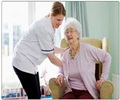Prototype robot nurses could be bustling around hospital wards in as little as three years, according to scientists in Germany who have developed ground-breaking software.
The mechanised "nursebots" being developed by the EU-funded scientists will perform basic tasks such as mopping up spillages, taking messages and guiding visitors to hospital beds.They could also distribute medicines and even monitor the temperature of patients remotely with laser thermometers.
Working in teams, the intelligent robots will be able to communicate with each other and co-ordinate their duties.
Scientists from universities in Germany, Ireland and Britain are among the engineers and software experts taking part in the IWARD project. They aim to have a three-robot prototype system ready by 2010.
It is hoped the machines will ease pressure on hospitals and free staff to spend more time with patients.
By helping to keep wards cleaner, they could also cut infections by hospital superbugs such as MRSA.
Advertisement
It might be fitted with a laser thermometer, which can measure body heat from a distance or cleaning equipment to mop up spills.
Advertisement
Project leader Thomas Schlegel, from the Fraunhofer Institute in Germany, has developed the advanced software.
"The idea is not only to have mobile robots but also a full system of integrated information terminals and guide lights, so the hospital is full of interaction and intelligence," says Schlegel.
"Operating as a completely decentralized network means that the robots can co-ordinate things between themselves, such as deciding which one would be best equipped to deal with a spillage or to transport medicine."
He says the robots could provide a valuable service guiding people around the hospital. A visitor would state the name of a patient at an information terminal and then follow a robot to the correct bedside.
If the nearest robot was not sure of a patient's location, it could seek help by communicating with others in the right area.
The robots would be fitted with sensors and cameras allowing them to avoid collisions while travelling through wards and corridors.
High-speed lanes could allow them to move from place to place quickly.
The robots would also employ face and voice recognition technology to communicate with patients and spot unauthorized visitors.
"The human-robot interaction will be tricky, as the robots will have to be able to deal with people with different injuries and disabilities as well as the elderly and seriously ill patients," says Schlegel.
Source-IANS
SRM




